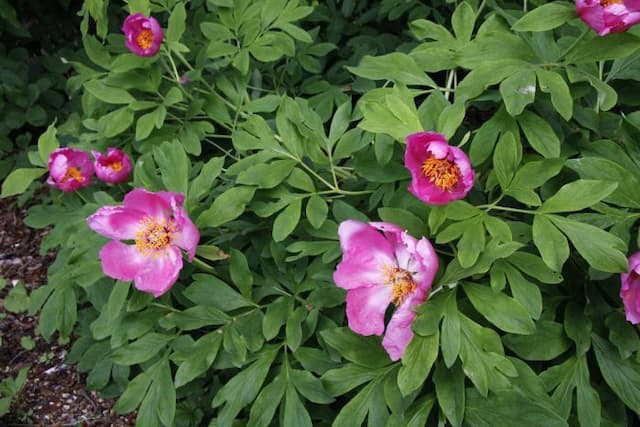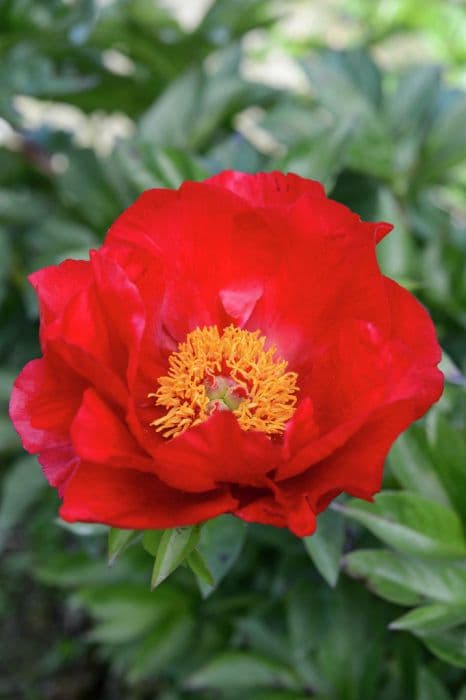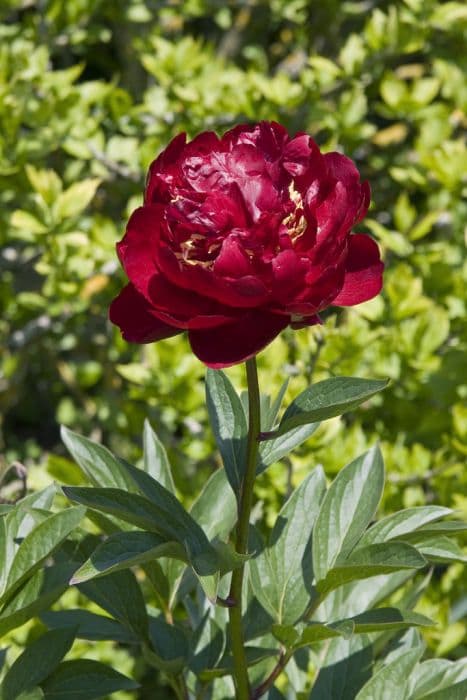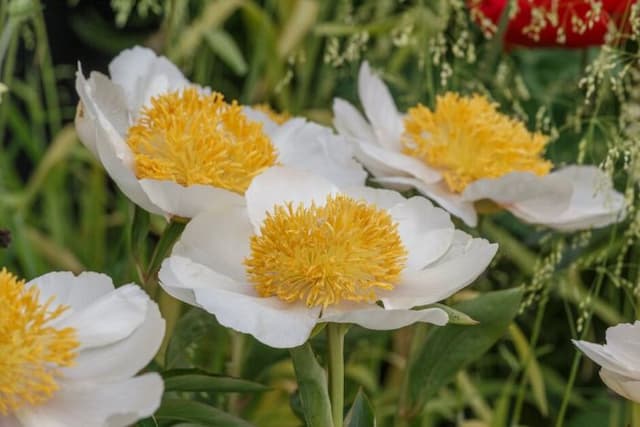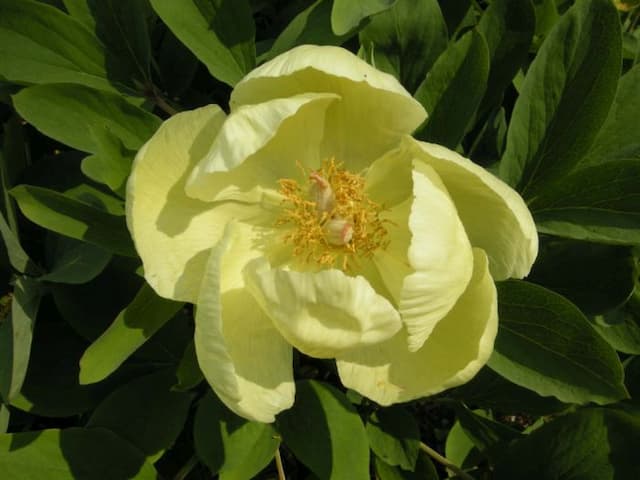Chinese Peony Paeonia lactiflora 'Gleam of Light'

ABOUT
The plant known as the peony 'Gleam of Light' is a perennial that showcases a striking appearance with a lush, vibrant display. The foliage is a deep green, with large leaves that provide a rich backdrop to the flowers. The blossoms themselves are often lush and full, with a multitude of delicate, overlapping petals. The color of the flowers in the 'Gleam of Light' variety is typically a soft, creamy hue, sometimes with a flush of pink or peach at the base of the petals or along their edges. The center of each flower is usually adorned with contrasting golden-yellow stamens that add a touch of brightness, creating a dazzling effect that gives this plant its name. The flowers exude a pleasant fragrance that is both sweet and subtle, attracting pollinators and enchanting garden visitors alike. Overall, the peony 'Gleam of Light' presents a picture of elegance and grace, with its lavish blooms and refreshing colors making it a standout addition to any garden setting.
About this plant
 Names
NamesFamily
Paeoniaceae
Synonyms
Chinese Peony, Common Garden Peony
Common names
Paeonia lactiflora 'Gleam of Light'.
 Toxicity
ToxicityTo humans
Peony, specifically the Paeonia lactiflora 'Gleam of Light', is not considered highly toxic to humans. However, peonies contain a compound called paeonol which can cause mild gastrointestinal upset if ingested in significant amounts. Symptoms might include nausea, vomiting, or diarrhea. Moreover, handling the plant, particularly the flowers and buds, can sometimes lead to skin irritation in sensitive individuals. Ingesting parts of the peony should be avoided and medical attention should be sought if symptoms arise following ingestion, particularly for children who might be more sensitive to its effects.
To pets
Peony, which refers to Paeonia lactiflora 'Gleam of Light', is considered to be potentially toxic to pets such as cats and dogs. Ingesting peonies can lead to gastrointestinal upset in pets, which can include symptoms like vomiting and diarrhea. Although it's not typically considered fatal, peony ingestion can be quite uncomfortable for your pet and veterinary attention might be needed if symptoms are severe or persistent. It's always a good idea to keep peonies out of reach of curious pets to avoid any potential issues.
 Characteristics
CharacteristicsLife cycle
Perennials
Foliage type
Deciduous
Color of leaves
Green
Flower color
Pink
Height
2-3 feet (60-90 cm)
Spread
2-3 feet (60-90 cm)
Plant type
Herb
Hardiness zones
3-8
Native area
Asia
Benefits
 General Benefits
General Benefits- Ornamental Appeal: Paeonia lactiflora 'Gleam of Light', commonly known as the Chinese Peony, has large, fragrant flowers that add aesthetic value to gardens and landscapes.
- Longevity: Chinese Peonies are known for their long lifespan, capable of thriving for decades in the right growing conditions.
- Cold Hardiness: This variety is well-suited to colder climates, able to withstand low temperatures and frost.
- Seasonal Interest: Provides seasonal interest with its lush foliage in spring and summer, and attractive seed pods in the autumn.
- Attracts Pollinators: The blossoms attract bees and other pollinators, which are essential for the health of ecosystems and the productivity of gardens.
- Easy to Care For: Once established, Chinese Peonies require minimal maintenance, making them a convenient choice for gardeners.
- Deer Resistant: These plants are generally resistant to deer, which can be beneficial for gardens in areas with high deer populations.
- Versatile Landscaping: Can be used in a variety of garden designs, from borders and beds to cut flower gardens.
 Medical Properties
Medical Properties- Anti-inflammatory: Paeonia lactiflora may contain compounds that have anti-inflammatory effects.
- Analgesic: It has been traditionally used to relieve pain.
- Immunomodulatory: There may be elements within Paeonia lactiflora that can modulate the immune system.
- Antioxidant: Extracts from the plant could have antioxidant properties.
- Neuroprotective: Some studies suggest that it could offer protection against neurological diseases.
- Cardiovascular health: The root of Paeonia lactiflora might improve cardiovascular health by acting on the blood vessels.
- Antispasmodic: Peony is sometimes used for its potential to relieve muscle spasms.
- Anticonvulsant: There is some evidence to suggest that it might help in reducing seizures.
- Hormonal regulation: Traditional use includes the regulation of hormones, particularly in women's health issues.
- Liver protection: It may offer some protection against liver damage.
 Air-purifying Qualities
Air-purifying QualitiesThis plant is not specifically known for air purifying qualities.
 Other Uses
Other Uses- Cut Flowers: Paeonia lactiflora 'Gleam of Light' can be used in floral arrangements due to their large, fragrant blooms that add elegance and a sweet aroma to any bouquet.
- Wedding Decor: The white petals and lush foliage of Peony 'Gleam of Light' make it ideal for wedding ceremonies as centerpieces or decoration for the venue.
- Garden Design: Due to its striking appearance, the plant can play a focal point role in a cottage-style or formal garden design.
- Photography Prop: The Peony 'Gleam of Light' is an excellent subject for photographers looking to capture the beauty of flowers in their natural or styled shoots.
- Dye Production: The petals of the Peony 'Gleam of Light' can be used to create natural dyes for coloring fabrics or art materials with delicate shades of pink.
- Artistic Inspiration: Artists may use the stunning blooms as a muse, drawing inspiration from their form and color for paintings, drawings, or fashion designs.
- Educational Tool: This plant can be used in schools or educational gardens to teach about plant growth, pollination, and the lifecycle of perennial plants.
- Soil Improvement: Peony 'Gleam of Light' can help improve soil quality through its root system, which can help aerate the soil and enhance its structure over time.
- Seasonal Celebrations: Its springtime bloom can be synonymous with certain festivals or seasonal celebrations, serving as a natural decoration or symbol during these events.
- Companion Planting: Peony 'Gleam of Light' can be planted alongside other perennials in the garden to create a succession of blooms, supporting pollinators throughout the growing season.
Interesting Facts
 Feng Shui
Feng ShuiPeonies are commonly used in Feng Shui to promote romance and prosperity. They are often placed in the southwest corner of the garden or home to enhance love and marriage prospects.
 Zodiac Sign Compitability
Zodiac Sign CompitabilityThe Peony is not used in astrology practice.
 Plant Symbolism
Plant Symbolism- Honor: In various cultures, the peony, including Paeonia lactiflora 'Gleam of Light', often represents honor and high esteem. It is associated with respecting and valuing others.
- Romance: Peonies are commonly known for their lush, full blooms, which make them a symbol of romance and romantic love, as well as affection between partners.
- Prosperity: With their full and round shape, peonies symbolize wealth and prosperity. They are considered good omens for economic abundance.
- Beauty: The peony, with its attractive flowers, is often seen as a symbol of beauty in both physical and abstract forms.
- Good Fortune: In some traditions, peonies are considered to bring good luck and are believed to ward off negative energies.
- Compassion: The soft and gentle appearance of the peony can be representative of compassion and nurturing.
 Water
WaterPeony 'Gleam of Light' should be watered deeply once a week during the growing season, ensuring moisture reaches the roots. In terms of volume, pour about 1 inch of water over the soil around the peonies, which is approximately 0.6 gallons per square foot. During hot and dry spells, watering may need to be increased to twice a week. It's crucial to avoid overhead watering to keep the foliage dry and prevent fungal diseases. During the winter months, when the plant is dormant, reduce watering significantly, only to keep the soil from drying out completely.
 Light
LightPeonies like 'Gleam of Light' thrive in full sun, requiring at least six hours of direct sunlight each day. They can tolerate light afternoon shade, especially in hot climates, but too much shade will reduce flowering. Choosing a spot that receives morning sun is ideal, as it helps dry dew from leaves, reducing the risk of fungal diseases.
 Temperature
TemperaturePeonies such as 'Gleam of Light' prefer temperate climates and are hardy in temperatures as low as -20°F. They can generally withstand the summer heat if they are well-watered. The ideal temperature range for growing peonies is between 65°F and 75°F during the growing season. They require a period of winter chill to set buds, so they may not perform well in zones without a cold period.
 Pruning
PruningPeonies like 'Gleam of Light' should be pruned to remove spent flowers after blooming to maintain a tidy appearance and prevent seed formation which can exhaust the plant. In fall, typically after the first frost, cut back the foliage to the ground to help prevent overwintering diseases. Remove all the cuttings and any fallen debris from the area to reduce the chance of disease in the following season.
 Cleaning
CleaningAs needed
 Soil
SoilPeony 'Gleam of Light' thrives in well-draining soil enriched with organic matter. A mix of loam, peat moss, and perlite or sand works well. Ideal soil pH for peonies ranges between 6.5 and 7.5 to ensure optimal growth.
 Repotting
RepottingPeonies, including 'Gleam of Light', rarely need repotting as they prefer to be left undisturbed. They should only be repotted or divided if they outgrow their space or after many years when flowering diminishes.
 Humidity & Misting
Humidity & MistingPeony 'Gleam of Light' is tolerant of a wide range of humidity levels. Average outdoor humidity is suitable, without the need for any special adjustments.
 Suitable locations
Suitable locationsIndoor
Provide bright indirect light, ensure good air circulation.
Outdoor
Plant in full sun to part shade, in nutrient-rich, well-drained soil.
Hardiness zone
3-8 USDA
 Life cycle
Life cyclePaeonia lactiflora 'Gleam of Light', commonly known as Chinese peony or common garden peony, begins its life cycle when seeds germinate in soil, typically requiring a period of cold stratification to break dormancy. Once the seedlings emerge, they grow into herbaceous perennials with a clump-forming habit, developing a root system and foliage in the first year, but often not flowering until the following seasons. Over the years, the plant matures and forms a robust rootstock with multiple eyes from which stems grow annually. Flower buds develop at the tips of new growth in early spring, leading to the blooming stage in late spring to early summer where large, fragrant flowers unfold in various shades of pink, red, white, or yellow. After flowering, the plant sets seed in the form of a dry capsule which, when mature, opens to release the seeds for dispersal. In fall, the plant's foliage dies back to the ground, entering a period of dormancy during the winter before regenerating in the next growing season.
 Propogation
PropogationPropogation time
Early fall
Paeonia lactiflora 'Gleam of Light', commonly known as Chinese peony, is typically propagated by division, which is the most popular method. This process involves the separation of the plant's root system to create new, independent plants. The ideal time to carry out division is in the fall, as the plants begin to go dormant. To propagate by division, carefully dig around the peony to lift the clump from the ground. Wash off the soil so you can clearly see the roots and eyes—these are the potential growth points for next year's shoots. Using a sharp knife, cut the clump into sections, making sure each section has at least three to five eyes. Replant these sections immediately, ensuring the eyes are no more than 2 inches (about 5 centimeters) below the soil surface.
